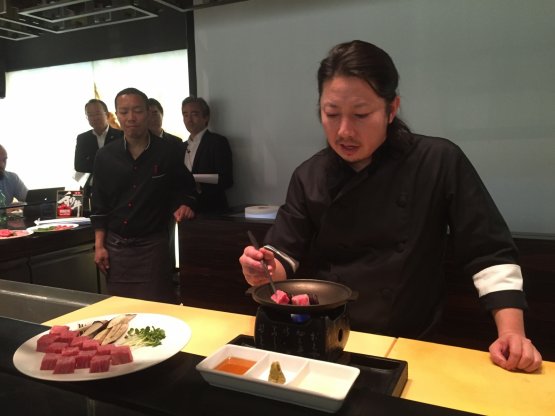Is Wagyū conquering Europe? Little over a year ago – in June 2014 – the UE ban to the import of this meat, a beef of the black Japanese variety Kuroge Washu considered the best in the world, was lifted. Today, the best restaurants in London, Paris, Frankfurt and Munich have it in the menu. It is now the turn of Italy, an important test bed, given the competition of famous Italian alternatives, the Chianina and Razza piemontese above all.
The gauntlet, however, has been thrown down and has as its protagonist group Ja (Japan Agricultural Cooperative), a real giant in this sector, representing over 4 million partners and around one thousand agricultural co-ops all around the island. It is one of the main sponsors of Japan’s events at Expo 2015 and presents, on this very day, 11th July, “Wagyū a Milano”.

Chef Hide Shinohara of the Zero contemporary food in Milan, at work yesterday with wagyū beef
This promotional campaign has nine restaurants in Milan involved, offering Japanese or Italian cuisine. Their chefs, as of today and until supplies end, will offer their interpretation of “
wagyū Zen-Noh” (Zen-Noh is the Japanese abbreviation for the Ja group) in their menu, for a promotional price, depending on each restaurant – for other info visit the website of each establishment. Here are their names: Botinero, Cracco, Finger’s Garden, Finger’s Milano, La griglia di Varrone, Manna, Tokuyoshi, Sushi B and Zero contemporary food.
It is a unique chance to taste this meat, a true delicacy. And as always the case with food excellences, this meat has imitators scattered around the world. In these years when imports were banned, the wagyū beef available in Italy was in fact arriving from countries such as the US, Australia, New Zealand, Spain. A good product, in many cases, yet just a feeble copy of the authentic, almost-unknown products at our latitudes: just think that the total production in Japan is of around 150-160K tons per year, and exports reach only 1,350 tons, thus less than 1%. In Europe, only 100 tons arrive, of which 35-40% under the Ja brand (while Australia alone exports around 3K tons per year … a real paradox, given the word wagyū in fact means “Japanese meat”).
So quantities are still very low but the ambition is to grow, and a lot too. First of all, by making the European consumer understand the quality of the meat. The first shipment arrived in Europe on 9th July 2014: the government of Tokyo has the intention of increasing exports to around 25 billion yens by 2020 (around 250 million dollars).
The goal is not impossible, given the product is of the highest quality. It derives from a special selection, just think that the ancestor of the around 100K current
Kuroge Washu cows for reproduction is
Hirashigekatsu, the super-ox born in 1990, which lived 18 years and had 300K calves. A bovine registry guarantees the lineage from this unique branch, said master
Motohiro Tanaka, of the Federal Meat Academy of Japan, yesterday. Each veal has an “I.D.” indicating parents, grandparents and great-grandparents; it also has a name identifying it, so as to guarantee a total traceability, which is compulsory since 2003. There’s also a sort of digital footprint, which is in fact the muzzle-print: it works in the same way.
The result is a very special meat, with a strong marbleisation, thus with abundant fat between the muscles which makes it extremely soft, and little fat under the skin. It is also very rich in oily fats, the same that can be found in our extra virgin olive oil: this lowers the cholesterol, to begin with, and thus makes the fat “good”, or at least better. It also lowers the point of fusion of the fat itself, so it melts in the mouth. And it gives a unique aroma. Finally, a rigorous classification system allows discerning the quality of the product. All this, of course, comes at a price: in London, a wagyū loin costs between 200 and 300 pounds, that is to say 4 or 5 times the price of European beef. Is it worth it? The Wagyū a Milano project intends to prove that the answer is yes.